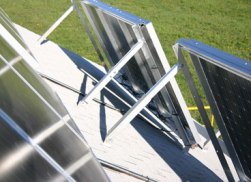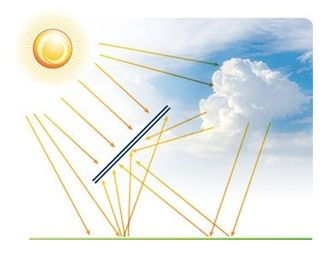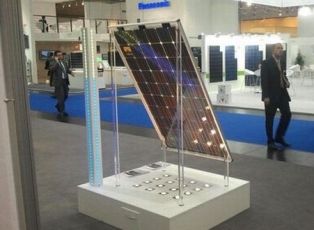Categories: Featured Articles » Interesting electrical news
Number of views: 11767
Comments on the article: 0
Bilateral solar cells
 Despite the fact that bilateral solar cells have been popular since the 1960s, their commercial use in photovoltaic projects is something relatively new. In the past, the use of bilateral solar cells made no sense in terms of costs, but now this has changed dramatically.
Despite the fact that bilateral solar cells have been popular since the 1960s, their commercial use in photovoltaic projects is something relatively new. In the past, the use of bilateral solar cells made no sense in terms of costs, but now this has changed dramatically.
What are two-sided solar cells
Bilateral solar cells are cells with two-sided photosensitivity. Their productivity is the same on both sides, and the efficiency reaches 22%. As a rule, monocrystalline.
While the solar panel is installed on the ground or on the tracker system, it accumulates light reflected from the ground. If you install it vertically, then solar battery will accumulate light from two sides, while the sun moves from east to west.
The use of double-sided solar cells
Reflective designs
From an economic point of view, we are close to using reflective structures on a large scale. Using such designs, we can achieve an increase in electricity production by 10-30% in comparison with these indicators.

Bilateral solar cell
Noise barriers
Solar cells can be installed on noise barriers along roads and railways.
Due to the vertical position of such barriers, the installation of solar panels on them requires less space than their usual installation towards the south, in which, in addition, it is necessary to arrange the structure at a certain angle.
When bilateral solar cells are installed vertically, they should be directed from north to south. If arranged in this way, they will generate almost the same energy as when installed in a southerly direction.
Solar trackers
Solar trackers with a polar axis are ideal for double-sided solar cells. Since there is enough free space under the solar panels, the rays of the sun can freely reflect from the system and reach the back of the solar cell.
Energy collection using solar trackers with a polar axis is higher compared to fixed photovoltaic systems. Also, air cooling of the modules is better, which leads to less loss.

Space
Bilateral solar cells have been used in space since the 1970s. The reason for this was their increased power / weight ratio, and, obviously, the cost of solar cells did not matter in space projects.
During this time, it has already been proven that bilateral solar cells absorb less infrared rays, which leads to lower operating temperatures and, as a result, to better functioning of the solar cell. An increase in efficiency of 10-20% was recorded compared to single-sided solar cells.
There are many other ways to use bilateral solar cells: remember balconies, bus stops, awnings, facades, fences, etc. Currently, their development is gaining momentum.
Expenses
Not only determine whether bilateral solar cells will be used on a large scale, but still their prices should be somehow reduced.
Obviously, an important requirement is the transparency of the solar panel on both sides. Most manufacturers cellophane it with glass.
In this case, even thin glass with a thickness of 2 mm can be used instead of 3.2 mm, but the disadvantage is that the glass is expensive and fragile. Do not underestimate the additional costs that arise when installing fragile solar panels.
Another option is to use a transparent TPT film.But be that as it may, transparency and its resistance to ultraviolet rays are less than that of glass.

Benefits
- Ability to install in any direction
- The installation direction of the two-sided solar cell is not so important, therefore, its structure has fewer disadvantages.
- vertical position
- Thanks to the possibility of installing a double-sided solar cell vertically, neither snow nor sand does not particularly interfere with the battery.
disadvantages
The two-sided solar cells that are currently being produced are made of double glass, which significantly adds to its price. In addition, glass makes solar cells fragile.
Manufacturers
Bilateral solar cells are manufactured by Sanyo, Hitachi, B-Solar and Prism Solar. They produce batteries of different models. Their structure is similar, but not the same, which leads to a difference in appearance and function. However, all manufacturers use two-way transparent encapsulation.
Translation from English.
Another article on this topic: Solar power plants for the home
See also at bgv.electricianexp.com
:

